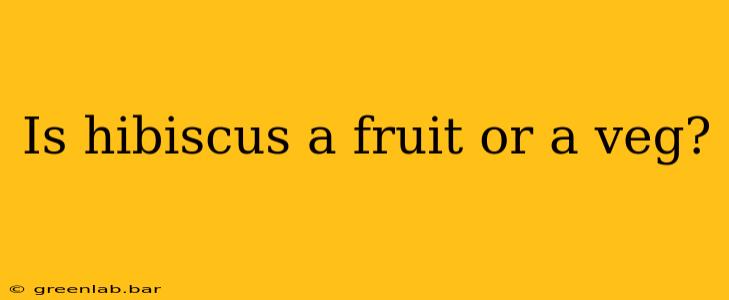The question of whether hibiscus is a fruit or a vegetable often sparks confusion. The answer, however, isn't as straightforward as a simple "fruit" or "vegetable." The confusion stems from the way we use these terms in everyday language versus their strict botanical definitions.
The Botanical Perspective: Hibiscus is a Fruit
From a botanical standpoint, hibiscus is a fruit. Botanically, a fruit is defined as the mature ovary of a flowering plant, containing seeds. The hibiscus flower, after pollination, develops a capsule containing seeds. This capsule is the fruit of the hibiscus plant. Therefore, regardless of how we use it culinarily, hibiscus falls squarely into the botanical fruit category.
Different Parts, Different Uses
This botanical classification doesn't necessarily dictate how we use hibiscus. We often use various parts of the hibiscus plant, leading to the confusion. For example:
- Calx: The vibrant, colorful part we typically associate with hibiscus, often used to make tea, is actually the flower's calyx (the base of the flower). While part of the plant that develops into the fruit, the calyx itself isn't the fruit.
- Fruit (Capsule): The actual fruit is a dry, five-lobed capsule that contains the seeds. It is less commonly used for culinary purposes than the calyx.
Culinary Considerations: The Fuzzy Line
In culinary terms, the distinction between fruit and vegetable becomes far less precise. We often classify foods based on taste and usage rather than strict botanical definitions. Hibiscus, with its tart and slightly tangy flavor profile, is frequently used in savory dishes alongside vegetables.
This culinary usage contributes to the perception of hibiscus as a vegetable, even though botanical classification dictates otherwise. Think of tomatoes: botanically a fruit, but often used as a vegetable in cooking. Hibiscus shares a similar culinary ambiguity.
Common Uses of Hibiscus
Hibiscus is valued globally for its culinary and medicinal properties. Here are some common uses:
- Hibiscus Tea: Perhaps the most well-known use, hibiscus tea is a refreshing beverage enjoyed worldwide for its tart flavor and potential health benefits.
- Culinary Ingredient: Hibiscus is added to sauces, jams, jellies, and even some savory dishes for its unique flavor and vibrant color.
- Medicinal Properties: Hibiscus has been used traditionally for various medicinal purposes, though further research is needed to confirm all its purported benefits.
Conclusion: A Matter of Perspective
Ultimately, whether you consider hibiscus a fruit or a vegetable depends on your perspective. Botanically, it's undeniably a fruit. However, its culinary applications and flavor profile often lead to its categorization as a vegetable in everyday conversation. Understanding both the botanical definition and the common culinary usage helps clarify the seemingly contradictory classifications.

